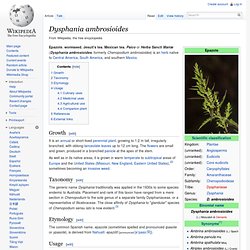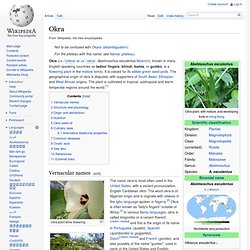

Medicinal plants & herbs. Winter Squash - Vegetable Directory - Watch Your Garden Grow. Winter squash is a warm-season vegetable that can be grown in most of the country.

It differs from summer squash in that it is harvested and eaten in the mature fruit stage, when the seeds within have matured fully and the skin has hardened into a tough rind. When ripened to this stage, fruits of most varieties can be stored for use throughout the winter. Recommended Varieties The following varieties of squash are adapted to a wide variety of conditions. They are vining types unless otherwise indicated. Dysphania ambrosioides. Dysphania ambrosioides - MHNT Epazote, wormseed, Jesuit's tea, Mexican tea, Paico or Herba Sancti Mariæ (Dysphania ambrosioides, formerly Chenopodium ambrosioides) is an herb native to Central America, South America, and southern Mexico.

Growth[edit] It is an annual or short-lived perennial plant, growing to 1.2 m tall, irregularly branched, with oblong-lanceolate leaves up to 12 cm long. The flowers are small and green, produced in a branched panicle at the apex of the stem. As well as in its native areas, it is grown in warm temperate to subtropical areas of Europe and the United States (Missouri, New England, Eastern United States),[2] sometimes becoming an invasive weed. Taxonomy[edit] The generic name Dysphania traditionally was applied in the 1930s to some species endemic to Australia. Etymology[edit] The common Spanish name, epazote (sometimes spelled and pronounced ipasote or ypasote), is derived from Nahuatl: epazōtl (pronounced [eˈpasoːt͡ɬ]).
Usage[edit] Culinary uses[edit] How to grow caraway (carum carvi)- growing herbs. During its first year, caraway grows about 20 cm high and then reaches about 60cm in the second.

In the second year, flat, umbrella like clusters of greenish white flowers appear on the stems above the foliage and in midsummer ripen into seeds-after which the plant dies. Foliage is delicate and lacy, like that of carrots. A native of southeastern Europe and western Asia, caraway has been in use for thousands of years. Seeds which are believed to be caraway have been found in ancient lake villages in Switzerland.
Ancient Greeks prescribed caraway seeds for bringing color back into the faces of girls with pale complexions. Start caraway from seeds sown in the fall or spring where they are to grow.
Growing Butternut Squash. This page provides instructions and photos on Growing Butternut Squash, which is a winter squash. For our model we will be using the Winter squash does not mean it can be grown during the winter. Squash is not self-pollinating therefore it will require bees and other insects to pollinate it. These insects are usually in hibernation during the wintertime. The term winter squash refers more to the time it is sold than the time it is planted. Growing butternut squash cannot be done in the winter time. There is a zucchini variety called the which is an organic zucchini that is self-pollinating. Fall is not a good time to plant winter squash or squash of any kind.
Winter squash usually requires at least one hundred plus days to mature depending on the variety, while summer squash can be ready in about fifty days. The is the standard butternut. The Waltham fruits are uniform, meaning "the same" and average about nine inches long and will weigh between four and five pounds. Jan 2011. Growing Asparagus In The Home Garden, HYG-1603-94. 2021 Coffey Rd., Columbus, Ohio 43210-1086 Carl J.

Cantaluppi Asparagus is a long-lived perennial vegetable crop that is enjoyed by many gardeners. It can be productive for 15 or more years if given proper care. Soil requirements Asparagus grows in most any soil as long as it has good internal drainage. Planting Buy one-year-old, healthy, disease-free crowns from a reputable crown grower. Asparagus can be planted from seed. Select the new all-male hybrid asparagus varieties such as Jersey Giant, Jersey Prince, and Jersey Knight. Asparagus can be planted throughout Ohio from mid-April to late May after the soil has warmed up to about 50 degrees F.
Dig a furrow no deeper than 5 to 6 inches. Toss the crowns into the furrow on top of the fertilizer. After planting, back fill the furrow to its original soil level. Do not harvest the asparagus during the planting year. Insects and Diseases Inspect the ferns throughout the season for insect feeding and fern dieback. Weed Control Harvesting Storage. TOMATILLO (Toma Verde) - The planting, growing and culture of Tomatillos.
Okra. Okra (US /ˈoʊkrə/ or UK /ˈɒkrə/; Abelmoschus esculentus Moench), known in many English-speaking countries as ladies' fingers, bhindi, bamia, or gumbo, is a flowering plant in the mallow family.

It is valued for its edible green seed pods. The geographical origin of okra is disputed, with supporters of South Asian, Ethiopian and West African origins. The plant is cultivated in tropical, subtropical and warm temperate regions around the world.[1] Vernacular names[edit] Okra plant while flowering Okra plants with leaves, fruits and a flower The name okra is most often used in the United States, with a variant pronunciation, English Caribbean okro. Structure and physiology[edit] The species is an annual or perennial, growing to 2 m tall.
Abelmoschus esculentus is cultivated throughout the tropical and warm temperate regions of the world for its fibrous fruits or pods containing round, white seeds. In cultivation, the seeds are soaked overnight prior to planting to a depth of 1–2 cm. Whole plant. Growing Arugula. Set out young arugula plants 12 to 18 inches apart.

Long popular in France and Italy, the leaves of arugula provide a spicy zap when added to a salad. This is the same plant sold in cellophane bags in the grocery store and usually labelled ‘baby arugula.’ However, we think that by growing arugula yourself, you’ll experience much more (and better) flavor. You decide! You can also saute or steam the leaves like spinach or other leafy greens. Chicory. "Chicory" is also the common name in the United States for curly endive (Cichorium endivia); these two closely related species are often confused.[6] Names[edit] Common chicory is also known as blue daisy, blue dandelion, blue sailors, blue weed, bunk, coffeeweed, cornflower, hendibeh, horseweed, ragged sailors, succory, wild bachelor's buttons, and wild endive.[7] (Note: "Cornflower", is more commonly applied to Centaurea cyanus.)
